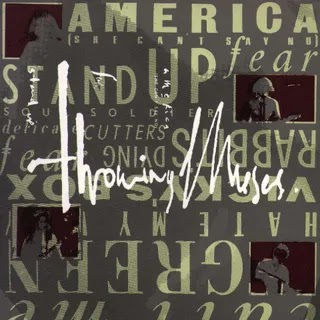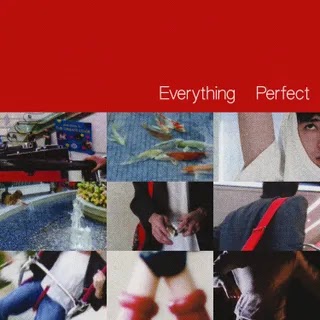Each Sunday, Pitchfork takes an in-depth look at a significant album from the past, and any record not in our archives is eligible. Today, we revisit the essential 1986 debut from the vibrant and visceral Rhode Island indie rock band, the first American group signed to 4AD.
“A living song is dirty, a dead one clean.” So goes one of Kristin Hersh’s many theories of music. If this is the theory, then her band’s 1986 debut, Throwing Muses, is the proof. Songs tear themselves apart and reattach at odd angles. Hersh, without warning, will snarl out a line in a guttural roar otherwise reserved for metal singers. Guitarist and vocalist Tanya Donelly will play a line out of step with the rest of the arrangement, sweeten that which you would not expect to be sweetened, or invite in some ghosts with a whispered vocal beneath the track. Bassist Leslie Langston will design lines like labyrinths. David Narcizo’s precision drumming acts as rivets under strain, holding the song together but barely. The songs themselves are precocious yet visceral, about life in all its grime. Love is a battlefield rendered in gory closeups. Sex is likened to a pigeon crushed under a car tire. The music is alive, and it is dirty.
Following the Muses in the early years, the dirt might not have been immediately apparent. Hersh and Donelly were step-sisters who grew up in musical families—each received a guitar from the other’s father. Around age 14, they started a band with two classmates at Rogers High School in Newport, Rhode Island with bassist Elaine Adamedes and drummer Becca Blumen. (Narcizo and Langston would join later.) The band’s early songs were less rock than lo-fi new wave, running on tinkly Casio and teenage enthusiasm, but they had the bones of Throwing Muses: Hersh and Donelly’s sugary harmonies, the scrappy confidence of a band. Originally named the Muses, the band added the “Throwing” as a reference to a passage Hersh had read by philosopher Martin Heidegger (they’d later distance themselves from it after learning about Heidegger’s entanglement with Nazism).
Everything was proceeding rather normally as high-school bands go; a profile in The Cowl, a Providence college paper, quotes Narcizo as looking forward to the summer and “a chance to define ourselves”: a fifth member, a synth, more percussion. But shortly thereafter, a 16-year-old Hersh was hit by a car while biking. Her head was severely injured, and she recalls hallucinating songs ever since: songs made of trauma and teeth, whose voice was the demonic roar Hersh would be known for on record and stage. She wrote most of these in a ramshackle apartment she called the Doghouse, in a frenzy of deteriorating health. “I can’t even remember what it was like to hear a song that didn’t grab my face and shout at it,” she recalled in her 2010 memoir Rat Girl. “Must’ve been soothing. But this is electrifying.”
At the urging of producer Gary Smith, who would later shepherd the Pixies to fame, the band moved to Boston and became regulars in the burgeoning college-rock circuit there. Two interviewers from a Rhode Island School of Design campus magazine introduced the Muses to the Cocteau Twins and suggested they contact their label, the legendary British outfit 4AD. Awestruck with the sound of dream pop—“It was like heaven music,” Donelly recalls—Throwing Muses sent some early demos to co-founder Ivo Watts-Russell. Watts-Russell, reminded of Nick Cave’s the Birthday Party, struck up a cross-pond pas-de-deux with the Muses, talking about anything and everything besides signing them because, as he’d mention ruefully, 4AD didn’t sign American bands. But soon, the pretense was dropped, the Muses were indeed signed, college-rock producer Gil Norton was assigned to work with them, and everything began.
Not that everything went smoothly. Throwing Muses is an idiosyncratic and uncopyable debut, but it’s also the product of internal and external tension. To make the album cohere, Watts-Russell nixed most of the goofier material and Americana tracks from the band’s repertoire. Hellspawn songs don’t always translate to full-band arrangements—Narcizo often found himself simply drumming along to the lead line, Langston wrote basslines that turned the arrangement into a thatch, then Donelly found herself, as Hersh recalls, “fitting parts over the mesh.” The resulting cassette of demos was surprisingly straightforward, but Norton was still tasked to pump the songs up, smooth them over—especially noticeable on the intro to “Vicky’s Box,” jangly and thick with sound compared to its cassette counterpart. This was new to the band—even the studio Watts-Russell rented was plush and disorienting compared to the band’s upbringing in communes and college crash pads.
Hersh, meanwhile, had become pregnant with her first child, Dylan, while still working through severe PTSD from her bicycle crash. She was diagnosed with what at the time was called manic depression. While this didn’t stop the recording sessions—“I think it’s against the law to fire a band just because it’s pregnant,” Hersh recalled Langston saying—she held back during vocal takes, terrified that summoning the songs’ full demonic roar might somehow get through to her unborn child. She stopped taking the lithium she’d been prescribed since the tremors it gave her made it too hard to play guitar. The result was a protracted recording process and a seemingly endless amount of takes. At one point the band was nearly kicked out of the studio to make way for Deep Purple.
A more fundamental tension was Tanya Donelly’s role in the band. She was as prolific a songwriter as Hersh—as late as 1991’s The Real Ramona, she was still working through her teenage backlog of demos—but during the Muses’ early years, she’d only have one to a handful of songs per album. The press tended to see more resentment there than truly existed. Despite Hersh and Donelly’s images of being less and more poppy, respectively, Donelly was actually the more introverted of the two, at least when it came to interviews. She’s said the distribution of songs on the Muses albums was more a matter of logistics than feeling sidelined. Donelly wrote her demos as herself, instead of envisioning them as Throwing Muses tracks (unlike the songs she’d write for her 1993 debut with Belly, which she’d envisioned as the next Breeders album but couldn’t get cut). She has one track on Throwing Muses, “Green,” a tribute to a first love who died young. The song shows early signs of her surreal imagery: one’s memories coalescing into bodice-ripping form (“Then there were candles, and a phoenix burnt my bed”), and the pivotal line, “Kneel in my ashes, kneading them,” an uncannily striking metaphor for one’s first consuming love. The tempo is that of piecing together a morning after: two repetitive tick-tock guitar figures, drumbeats like tiptoes, finding their way to emotion. Langston’s bass plays the other party: loping along beneath the track, in its own cool, unconcerned world.
Dirty alive music gets you a certain sort of reaction. Fans attached to them hard, sometimes with the kind of obsession we’d call parasocial these days. Critics were intrigued and impressed but at a loss as to who to compare the band to—X, early R.E.M., the Raincoats, and the Slits were common reference points. Even while praising them, writers would comment on how “cryptic” the songs were, leaving it there in a self-fulfilling shrug, or remark that the music felt untrained or “unlearned.” Sometimes this aligns accidentally to reality: In most interviews, Hersh insists that she channels songs, or is possessed by them, rather than deliberately writing; when her father tried to teach her guitar, she preferred to make up her own chords.
But Donelly was a more deliberate songwriter, and her songs sound fully formed from the earliest bedroom demos. Narcizo was plucked out of marching band to join the Muses, and you can hear it in how he executes every swerve and about-face with precision. Langston’s famously knotty basslines came from her extensive background in California bands—jazz, funk, reggae, acid rock—and she was especially irked by the suggestion that the band was “untrained.” “You know how hard it is to play this way? Try it sometime!” Hersh’s memoir quotes her. “There aren’t any lessons to teach you how to do this.” To this day Hersh’s work plays up lead bass, perhaps inspired by Langston’s groundwork.
The lyrics, too, confounded listeners who expected straightforward punk polemic or spicy confessionals. (This included Norton; “Please stop listening to the lyrics,” Hersh eventually told him, after he’d prodded at the proper names and homosexuality references in “Vicky’s Box.”) But Hersh is a singular vocalist and writer, and her lyrics are straightforward once you know what they’re about. Much was made by early reviewers of “Hate My Way” and its brash salvo of an intro (“I could be a smack freak and hate society/I could hate God and blame Dad…”). As Hersh wrote in her memoir, the lyrics aren’t hers. They paraphrase a kid on campus who’d handed her a pamphlet and buttonholed her for a lecture: “We as a species have yet to rise above the church and take responsibility for our own actions. For example, say you’re a smack freak…” Hersh sets this to a guitar riff hammered at the tempo of a toddler’s stomped foot, with periodic pauses after each makes-you-think-huh? chant.
What follows is a gentle elegy—but the gentle part, as usual, is the part Hersh remembers as “a piece of Doghouse evil.” With the shift in tempo comes a shift in perspective, back to Hersh: “I make you into a song/I can’t rise above the church,” she sings, less mocking and more resigned. The track is suffused with wistfulness, with trying to explain just how bad things are and knowing that it isn’t going to work. The lyrics put Hersh in conversation with her bandmates—the line “My pillow screams too, but so does my kitchen, and water and my shoes, and the road” is likely a response to an earlier demo by Donelly, “Raise the Roses” (“I hear my pillow screaming, find him”). Trying to find anyone, anything, whose turmoil matches her own, she lands on James Oliver Huberty, a mass shooter who killed 21 people at a McDonald’s in 1984. While some of Throwing Muses’ subject matter has become less transgressive over the years, this if anything has become more; imagine anyone in 2022, after hundreds more such shooters, writing a song comparing herself to one.
Throwing Muses is full of tracks about this uncrossable distance. “So many people want to talk/They look in the mirror and see themselves,” Hersh and Donelly sing on “Call Me”—the implication being, what if you see someone else? The lyrics are full of Lovecraftian invocations of unspecified approaching doom, and the vocals border on voice-acting: snarling out warnings, punctuating lines with dramatic sighs, wilting at the end. For all the studio soft-focus Norton applied to the songs between cassette and debut, Hersh’s vocal delivery is largely the same, crucially fierce. To take one line: “Peter said, thanks for letting me ho-ho!ld you, calling me moonshine.” So much is said in one line: the snarling of the dude’s name; that ho-ho! in the middle like a crowing cartoon Falstaff; the subtext that this guy, like many men you encounter as a rock band of teenage girls, might not be entirely savory. The outro, a lilting recollection of loneliness, is one of the Muses’ most musically straightforward moments, and all the more so when you realize that when Hersh sings “Call me,” she means this: Call her something, anything that makes sense.
These questions of identity suffuse the album, as you’d expect from a record written by high schoolers. But unlike other teenage coming-of-age stories, there’s no clean resolution. “I’m losing my person,” Hersh sings in “America,” meaning herself. She writes secondary characters as kindred spirits: the young gay man outrunning his looming identities in “Vicky’s Box,” the titular rabbit of “Rabbit’s Dying,” expiring amid the Muses’ sludgiest arrangement. “Fear” is a meta-song: starting in medias res punctuated by car sirens, quoting the intro to “Call Me” and what would later become the guitar loop of The Real Ramona’s “Hook in Her Head.” Once again, as the song gets quiet, it gets mean. Donelly narrates, in sotto voce, the process of Hersh’s Doghouse songs creeping up through the body, “up to your face, up to your cheeks,” like a twisted meditation ritual to obliterate yourself through sound. While Donelly keeps going, unmovable, Hersh’s vocal goes wordless then erupts into a seething roar: the song’s true voice, severed from words.
In spite of, or maybe because of its singularity, Throwing Muses was bound to be somewhat obscure. 4AD labelmates such as Lush’s Miki Berenyi praised the band to no end, but their influence was otherwise indirect, through connections: Donelly would join the Breeders for their debut Pod, and Hersh would record with Michael Stipe and become acquainted with Mary Margaret O’Hara. The Muses got further traction through the Boston rock scene; Jonny Greenwood of Radiohead recalled seeing them in his teens and remarking that Boston “was so much cooler.” But Throwing Muses was never released in the United States until 1998, when Warner’s Rykodisc bundled it and its demo cassette into the two-CD compilation In a Doghouse compilation. Neither the original nor the compilation appear on major streaming services, so while the album isn’t exactly hard to find, it’s cut off from the algorithmic apparatus connecting, among others, future musicians with their future influences. Throwing Muses was always a submerged kind of album anyway: the primordial well from which myths emerge.









%20Music%20Album%20Reviews.webp)






0 comments:
Post a Comment